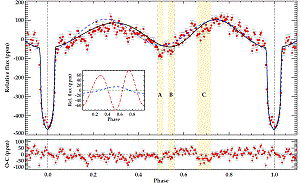- Details
- Published on 05 February 2014
Vol. 562
In section 10. Planets and planetary systems
Kepler-91 b: a planet at the end of its life
 KOI-2133 is a giant star observed by the Kepler spacecraft. It was identified as
an "object of interest" because of transits compatible with a planet-size object
on a 6.2-day orbit. However, a first study by Esteves et al. (ApJ 2013, 752, 51)
concluded that the transiting object had to be self-luminous on the basis of the
depth of its secondary eclipse so that it was probably a case of a false positive:
an eclipsing binary mimicking a planetary transit because of dilution by another
star. In this issue, Lillo-Box et al. very carefully examine the constraints that
can be obtained on the parent star through its oscillations and derive a mass of
1.3 solar masses and a radius of 6.3 solar radii. These results are significantly
different from what was derived previously. Solving for the orbital
characteristics of the companion, they obtain a mass of 0.9 Jupiter masses for a
radius of 1.38 Jupiter radii, a non-zero eccentricity of ~0.07, and an albedo
smaller than 0.4 (i.e., the object is not self-luminous). These parameters are typical of the standard hot Jupiters known so far. Nevertheless, the planet is orbiting so close to its star that it comes a mere 1.3 stellar radii away from the stellar photosphere, which is a
record! Future studies should shed light on the dynamical and thermal history of
planets and on star-planet tidal interactions. Besides this, this soon-to-be
engulfed planet now has a name: Kepler-91 b.
KOI-2133 is a giant star observed by the Kepler spacecraft. It was identified as
an "object of interest" because of transits compatible with a planet-size object
on a 6.2-day orbit. However, a first study by Esteves et al. (ApJ 2013, 752, 51)
concluded that the transiting object had to be self-luminous on the basis of the
depth of its secondary eclipse so that it was probably a case of a false positive:
an eclipsing binary mimicking a planetary transit because of dilution by another
star. In this issue, Lillo-Box et al. very carefully examine the constraints that
can be obtained on the parent star through its oscillations and derive a mass of
1.3 solar masses and a radius of 6.3 solar radii. These results are significantly
different from what was derived previously. Solving for the orbital
characteristics of the companion, they obtain a mass of 0.9 Jupiter masses for a
radius of 1.38 Jupiter radii, a non-zero eccentricity of ~0.07, and an albedo
smaller than 0.4 (i.e., the object is not self-luminous). These parameters are typical of the standard hot Jupiters known so far. Nevertheless, the planet is orbiting so close to its star that it comes a mere 1.3 stellar radii away from the stellar photosphere, which is a
record! Future studies should shed light on the dynamical and thermal history of
planets and on star-planet tidal interactions. Besides this, this soon-to-be
engulfed planet now has a name: Kepler-91 b.


